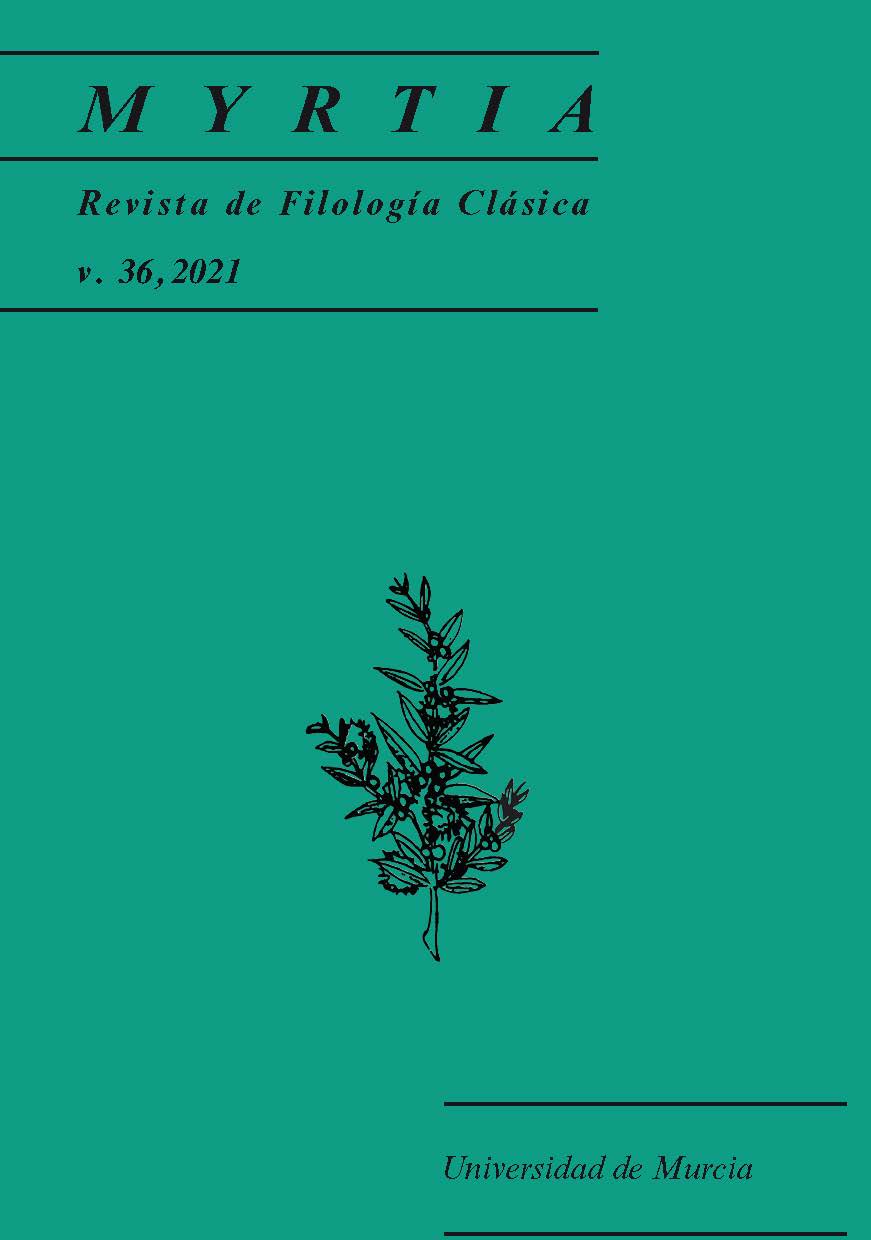Catullus 48, the field as image of the unsatisfied body
Abstract
This article proposes that the poetic use of agricultural vocabulary in Catullus’ carmen 48 is related to the frustration of a lover’s experience. The dual nature of the epigram and the intertextual and referential relationships inside the poem contribute to this interpretation.
Downloads
-
Abstract1359
-
PDF (Español (España))837
References
J. Adiego Lajara, 1989, “Observaciones en torno al ciclo de Juvencio en Catulo”, en Actas del VII Congreso Español de Estudios Clásicos, Madrid, pp. 427-433.
H. Akbar Khan, 1967, “Catullus 99 and the other Kiss-Poems”, Latomus 26, pp. 609-618.
F. Cairns, 1973, “Catullus’ basia poems (5, 7, 48)”, Mnemosyne 26, pp. 15-22.
U. Carratello, 1995, “Catullo e Giovenzio”, GIF 47, pp. 27-52.
F. Della Corte, 19722, Personaggi Catulliani, Florencia.
M. De Vaan, 2008, Etymological Dictionary of Latin and the Other Italic Languages, Leiden.
R. Ellis, 1968, A Commentary on Catullus, Oxford, 1876 (ed. digital Cambridge University Press 2010 https://www.cambridge.org/core).
A. Ernout & A. Meillet, 2001, Dictionnaire étymologique de la langue latine: histoire des mots ̧ París.
J. C. Fernández Corte & J. A. González Iglesias, 2006, Catulo. Poesías, Madrid.
C. González-Vázquez, 2000, "La Terminología Teatral Latina como Léxico Técnico", en Cien Años de Investigación Semántica: De Michel Bréal a la Actualidad, M. Martínez Hernández et al. (coords.), Madrid, pp. 1585-1598.
E. Green, 2011, “Catullus and Sapho”, en A Companion to Catullus, M. B. Skinner (ed.), Oxford, pp. 134-185.
S. Hawkins, 2011, “Catullus’ Furius”, Classical Philology 106, 3, pp. 254-260.
F. G. Hernández Muñoz, 2019, “Notas sobre traducciones españolas de dos fragmentos sáficos: fr. 137 d (= 130 v) y fr. 2 d (= 31 v)”, en Nunc est bachandum: Homenaje al Prof. Alberto Bernabé, S. Planchas, J. Piquero & P. de Paz (eds.), Madrid, pp. 475-488.
P. E. Knox, 2011, “Catullus and Callimachus”, en A Companion to Catullus, M. B. Skinner (ed.), Oxford, pp. 186-219.
M. Lenchantin de Gubernatis, 19452, Il libro di Catullo Veronese, Turín.
J. Luque Moreno, 2017, “Catulo 51 y 11: ¿final y comienzo de un amor?”, Florentia Iliberritana 28, pp. 123-133.
J. Luque Moreno, 2018, “Besos de Catulo”, Emerita 86, 1, pp. 71-91.
J. Luque Moreno, “Otium, Catulle, tibi molestum est?”, en Otium et negotium. El legado de Roma. VIII Congreso de la Sociedad de Estudios Latinos, I. Velázquez et al. (eds.), León (en prensa).
J. Luque Moreno, 2020, Vallerivs Catvllvs: Praelectiones Granatenses, Granada.
R.A.B. Mynors, 1958, C. Valerii Catulli Carmina, Oxford.
C. Pascal, 1916, Poeti e personaggi Catulliani, Catania.
A. Pérez Vega & A. Ramírez de Verger, 2005, C. Valerio Catulo, Carmina, edición, traducción y comentario, Huelva.
K. Quinn, 19692, The Catullan Revolution, Cambridge.
K. Quinn, 1972, Catullus. An Interpretation, Londres.
I. Rodríguez Alfageme, 1993, “El color y el sonido en Homero”, en La épica griega y si influencia en la literatura española, J.A. López Férez (ed.), Madrid, pp. 85-111.
M. Ruiz Sánchez, 1996, Confectum carmine. En torno a la poesía de Catulo, Murcia, 2 vols.
A. Salazar Valenzuela, 2017, “Poesía homoerótica en Catulo: textos y algunas consideraciones traductológicas”, Iter Traducciones 23, pp. 177-191.
O. Thévenaz, 2019, “Sapphic Echoes in Catullus 1-14”, en Roman Reception of Sappho, T. S. Thorsen & S. Harrison (eds.), Oxford, pp. 119-136.
G. Williams, 1968, Tradition and Originality in Roman Poetry, Oxford.
F. Vollmer & W. Morel, 1935, Poetae Latini Minores, I, Leipzig.
Las obras que se publican en esta revista están sujetas a los siguientes términos:
1. El Servicio de Publicaciones de la Universidad de Murcia (la editorial) conserva los derechos patrimoniales (copyright) de las obras publicadas, y favorece y permite la reutilización de las mismas bajo la licencia de uso indicada en el punto 2.
2. Las obras se publican en la edición electrónica de la revista bajo una licencia Creative Commons Reconocimiento-NoComercial-SinObraDerivada 3.0 España (texto legal). Se pueden copiar, usar, difundir, transmitir y exponer públicamente, siempre que: i) se cite la autoría y la fuente original de su publicación (revista, editorial y URL de la obra); ii) no se usen para fines comerciales; iii) se mencione la existencia y especificaciones de esta licencia de uso.
3. Condiciones de auto-archivo. Se permite y se anima a los autores a difundir electrónicamente las versiones pre-print (versión antes de ser evaluada) y/o post-print (versión evaluada y aceptada para su publicación) de sus obras antes de su publicación, ya que favorece su circulación y difusión más temprana y con ello un posible aumento en su citación y alcance entre la comunidad académica. Color RoMEO: verde.





